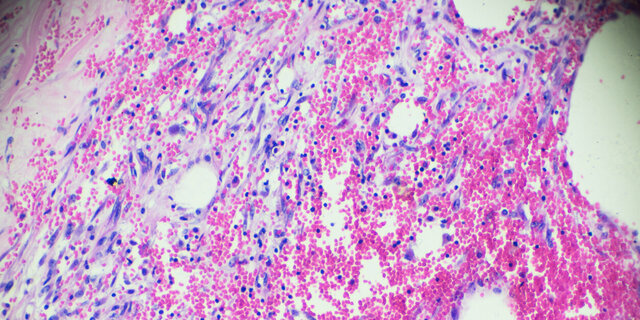Glossary
In our glossary, we explain the most important breast cancer terminology.
adjuvant
The term "adjuvant therapy" refers to treatment that is carried out following surgery of breast cancer. The aim is to reduce the recurrence rate and thus further increase the chances of cure.
Amputation
Surgical removal of a part of the body.
Anti-oestrogen therapy
See hormone therapy.
Aromatase inhibitor (AI)
Aromatase inhibitors are anti-hormone drugs. Some breast cancer cells need oestrogens to grow. Aromatase inhibitors inhibit an enzyme called aromatase, which is involved in the production of oestrogen.
See also: Hormone therapy.
axillary
Belonging to the axilla.
Benign tumour
Although these tumors are non-invasive, they can have a negative impact on health:
due to their size, if they press against organs or blood vessels in the case of endocrine tumors due to hormone overproduction
Biopsy
Removal of tissue, e.g. with a special needle, forceps or a scalpel, for microscopic examination.
BRCA genes
(BReast CAncer) Genes that contain certain mutations of the hereditary forms of breast cancer. These genes are called BRCA1 and BRCA2. They normally help to regulate the growth of cells. People with mutations in these genes have an increased risk of breast, ovarian, prostate and other cancers. People with many cases of breast or ovarian cancer in their family history should have a genetic test for the BRCA genes carried out by their doctor.
Breast reconstruction
Breast reconstruction is an operation to restore the shape of the breast after a mastectomy or lumpectomy. The material used for breast reconstruction can be the body's own tissue (such as fatty tissue) or synthetic material (such as silicone).
Breast-conserving surgery
A surgical procedure to remove a breast tumor tissue. Only the cancerous tissue and a few millimetres of surrounding tissue are removed. In most women, the previous appearance of the breast is retained. This operation is also known as a lumpectomy.
Breast ultrasound
High-frequency sound waves are used to obtain an image of the internal structure of the breast. Ultrasound can differentiate between solid lumps and fluid-filled cysts. See also ultrasound examination.
Cancer
see also: malignant tumour
Categorisation of breast cancer
Breast cancer is classified into different stages based on
- Tumour size
- Spread to the lymph nodes of the axilla and breast
- Spread to distant organs
An interdisciplinary team of physicians plans the individual therapy based on the classification. See also staging and TNM classification.
Checkpoint inhibitors
Checkpoint inhibitors belong to the group of immunotherapies. Checkpoint inhibitors increase the activity of the body's own immune system, which is slowed down by the tumor.
Chemotherapy
Treatment with chemical substances that inhibit the growth of tumor cells in the body. The term often refers specifically to cytostatic chemotherapy, i.e. the treatment of tumor cells with drugs that inhibit cell division (see also cytostatics).
Classification
Classification, categorisation into classes.
curative
curative, aimed for healing
Cell cycle
During the cell cycle, a cell produces an exact copy of its genetic information and divides into two identical cells. If this cell cycle does not run correctly, cells can divide uncontrollably. This can lead to serious diseases such as cancer.
Cyst
Sack-like tumor closed by a capsule with one or more chambers filled with fluid.
Cytology
The investigation of the structure and function of cells. In medicine, cytology is the examination of cells in liquid samples with the aim of diagnosing or recognising cancer, among other abnormalities.
Cytostatics
Drugs that inhibit the growth of tumor cells but can also damage healthy cells to a certain extent. They are intended to prevent cell division (see also chemotherapy).
Degree of malignancy
Term for the degree of malignancy of cells.
Diagnostics
Term for all examinations that are necessary to identify and precisely describe a disease.
Differentiation
Cell differentiation is the process by which cells change their shape and function so that they specialise in carrying out their intended activities. In other words, the maturation of cells for their specialised function; cancer cells are often undifferentiated and immature.
Distant metastasis
see metastasis
Ductal carcinoma in situ (DCIS)
DCIS is the earliest form of breast cancer in the milk ducts of the breast. Abnormal cells can be found in the lining of the milk ducts. These abnormal cells have not yet spread outside the milk ducts. In some cases, DCIS becomes an invasive cancer that spreads further into the breast.
Dysplasia
Abnormal cell maturation and differentiation that is often a precursor to neoplasia.
Endocrine therapy
Endocrine therapy (hormone treatment) is an anti-hormone treatment that inhibits either the production or the effect of oestrogen, the most important female sex hormone. See hormone therapy
Epithelial
Belonging to the upper cell layer of the skin and mucous membrane tissue.
Fatigue
Fatigue is a term for chronic exhaustion, which can be a concomitant symptom of various chronic diseases and also of tumour diseases and tumour treatments.
Germline mutation
A germline mutation is a mutation in the male and female germ cells (eggs and sperm). These mutations can be (partly) responsible for the development of cancer. The best known mutations in breast cancer patients affect the genes "BRCA1" and "BRCA2".
Grading
Assessment of the degree of malignancy of tumors according to certain evaluation criteria. Criteria include, for example, the similarity of tumour cells to cells of the affected organ or the rate of cell division in the tumur. The more normal the cells look, the less aggressive the cancer is and the slower it grows and spreads. On the other hand, the more abnormal the cells look, the more aggressive the cancer is and the faster it grows and spreads (see also TNM classification).
HER-2
Human epidermal growth factor 2, associated with aggressive cell growth of a breast carcinoma.
Histology/histological
The science and study of the fine structure of biological tissue.The examination of a tissue section under the microscope allows an assessment of whether a benign or malignant tissue proliferation (tumour) is present and may provide information on the site of origin of the tumour.
Hormones
Messenger substances that are produced in specialised cells and tissues and reach their site of action via the blood or lymphatic system.
Hormone receptor
See receptor for growth factors.
The determination of hormone receptors in breast cancer is important for deciding between supportive (adjuvant) or palliative (palliative) forms of therapy. A distinction is made between oestrogen and progesterone receptors.
Patients before the onset of the menopause (premenopause) have around 50 to 60 percent oestrogen receptors, patients after the onset of the menopause (postmenopause) have 70 to 80 percent.
These receptor-positive cases are considered to have a more favourable prognosis than receptor-negative tumours. In receptor-positive patients, hormone therapy (endocrine) measures also have a better chance of success.
Hormone therapy
In hormone therapy, cancer cells that have receptors for oestrogen and progesterone are directly attacked by drugs that block or stimulate these receptors. Another aim is to interrupt the hormone metabolism. This is achieved with drugs such as aromatase inhibitors.
In situ
In situ: (Latin). In the context of tumors, this means that the tumor is limited to the site where it originated and has not yet grown into neighbouring tissue or metastasised. The tumor has not yet spread.
Invasive
In surgery: penetrating organs or tissue.
In the case of tumors: growing into the surrounding connective tissue.
In vitro diagnostics
Examination of fluids or tissue carried out in test tubes.
In vivo diagnostics
Examination of organs and cells in their normal environment, i.e. within the body.
Ki-67
Ki-67 is a protein that is involved in cell proliferation. Tumors with a high proportion of Ki-67 grow faster than other tumors.
Lobular carcinoma in situ (LCIS)
In LCIS, the cells that form the inside of the glandular lobules are slightly altered. This leads to an increased risk of breast cancer. Nevertheless, most women diagnosed with LCIS will never develop breast cancer. However, the progression should be monitored by regular mammography examinations.
Lumpectomy
This term refers to breast-conserving surgery of breast cancer. Instead of removing the entire breast, only the tissue of the cancerous tumor and a "safety area" of surrounding healthy tissue are removed.
Lymphatic drainage
Stroking massage for the treatment and removal of lymph congestion caused by delayed lymph drainage, e.g. after a mastectomy. Light stroking and pressure massages of the hand and fingers distribute the fluids to other areas from which they can drain better.
Lymph nodes
Lymph nodes filter the tissue fluid (lymph) at numerous points in the body. They are an important part of the immune system. The frequently used term lymph glands is misleading, as the lymph nodes do not have a glandular function.
Lymph node dissection
The surgical removal of one or a group of lymph nodes if cancer cells are found in them.
Lymphoedema
Swelling in various parts of the body caused by restrictions in lymphatic drainage.
Lymphatic system
Part of the immune system that protects the body against infections and other diseases. It consists of the bone marrow, thymus, spleen and the lymph node system.
There are two main tasks for the lymphatic system:
1. protection of the body from infection
2. drainage of fluids from the tissue
Magnetic resonance imaging (MRI)
Examination procedure that works with magnetic fields and provides a high level of image information. MRI is often used to examine the brain and spinal cord and can also visualise pathological changes in other organ systems.
Malignant tumor
Synonym for "cancer". Malignant tumours are characterised by
Mammography
Visualisation of the mammary gland by X-ray examination.
Mastectomy
Breast amputation; an operation to remove the entire breast (and often also some lymph nodes in the axilla).
mental
mental
Metastasis
Metastasis of the original malignant tumor in other parts of the body. The risk of metastasis depends in particular on the type, location and blood supply of the primary tumor.
Metastasis
See metastasis. Metastasis is possible via the blood vessels (haematogenous) or via the lymphatic system (lymphogenous).
Nadir
Term for the lowest value of blood cells (especially leucocytes) that occurs during chemotherapy.
neoadjuvant (= preoperative) therapy
Chemotherapy, radiotherapy or hormone therapy used to shrink the tumour before surgery.
Oestrogen
Female sex hormone that triggers cell division and growth effects in the female reproductive system, for example in the mucous membrane and muscles of the uterus or in the mammary gland.
Ovarectomy
Removal of the ovaries. This operation is performed especially for hormone-sensitive tumors such as breast cancer and has a favourable effect on the course of the disease.
Palliative treatment
A palliative treatment that focusses on intensive pain therapy and the control of other disease-related symptoms of a disease without eliminating the disease that caused it. Palliative medicine is particularly important when a cancer patient can no longer be cured.
Physiotherapy
A form of specific training and the external application of remedies that is primarily intended to restore, improve or maintain the mobility and functionality of the human musculoskeletal system. The techniques are applied by or in the presence of the physiotherapist as part of a treatment plan individually tailored to the patient.
Pigmentation
Storage of body pigments in the cells of the skin.
Primary tumour
The first cancerous tumor from which metastases can spread.
Progestogen
Hormone of the female ovary that serves to prepare and maintain pregnancy (see also progesterone)
Progesterone
The luteal hormone is the most important natural progestogen. It acts together with oestrogens and is involved in regulating the function of almost all female reproductive organs.
Prognosis
In medicine, a prediction of the course, duration and outcome of a disease based on knowledge.
Prosthesis
Artificial replacement for an amputated or missing body part.
Radiotherapy
Cancer cells are destroyed by high-energy radiation. Normal cells can repair themselves, whereas cancer cells do not have this ability. There are various approaches:
- external radiation: The areas of the body where the tumor is located are irradiated.
- Internal irradiation: Small rod-shaped radioactive particles are introduced into the body close to the tumour.
- Radiotherapy during the operation.
Rehabilitation
All activities aimed at reintegration, medical recovery, occupational rehabilitation and social reintegration. This includes transitional assistance, transitional benefits, subsequent care of disabled persons and the elimination or reduction of occupational disability and incapacity for work.
Reconstruction
Restoration of a destroyed part of tissue.
Remission
Regression of a tumor. A distinction is made between complete and partial remission, depending on whether the tumour has completely or only partially regressed. A full remission may or may not be associated with a permanent cure.
Resection
Surgical removal of diseased organ parts.
Receptor for growth factors
A protein that is present in the cell or on the cell surface and binds to a specific growth factor protein. Growth factors are regulators for a number of cellular processes, e.g. cell division, cell growth and differentiation.
Recurrence
Recurrence of a tumor or other disease at the same original site.
Sentinel lymph node biopsy (SLNB)
Removal of a sentinel lymph node (sentinel lymph node). This is the first lymph node in the tumor drainage system and is most likely to contain metastases. If it has no metastases, it is very unlikely that the tumor has spread to other lymph nodes. If the sentinel lymph node is positive with a macrometastasis, i.e. a metastasis larger than 2 mm, further lymph nodes in the axillary region must be removed (axillary lymph node dissection). In the case of a micrometastasis, it depends on other factors whether more lymph nodes need to be removed.
Silicone
A gel-like mass that is often used in reconstructive surgery due to its good mouldability and compatibility, for example in breast reconstruction.
Sonography
See ultrasound examination.
Surgery
Breast surgery is still an integral part of breast cancer treatment. Today, most women can undergo breast-conserving surgery (lumpectomy). Breast removal (mastectomy) is necessary in around 20% of patients. Reconstructive surgery is also part of breast cancer treatment.
Staging (staging)
Staging is used to measure the spread of malignant tumors to neighbouring organs and other organs. The size of the original tumor (primary tumor), the number of affected lymph nodes and the metastases are included in the calculation (see also TNM classification, grading).
Symptom
Signs of a disease.
Scintigraphy/scintigram
Examination and imaging of internal organs with radioactively labelled substances. These substances appear as glowing dots in an X-ray image and thus enable black and white images of organs. The scintigram can be used to recognise abnormal areas in organs and initiate further examinations.
Targeted therapy
Newer cancer drugs are targeted against certain characteristics of cancer cells (see also: hormone therapy).
TNM classification
The classification of malignant tumors into groups according to their spread: T = tumour, N = lymph nodes, M = distant metastases. The individual stages of spread are described in more detail using index numbers. An early-stage carcinoma without metastasis, for example, is labelled T1N0M0.
Triple negative breast cancer
Triple negative breast cancer means that this tumour has none of the following surface receptors: Oestrogen receptor, Progesterone receptor, HER2 receptor
Tumor
Tumor that is not necessarily malignant. A malignant tumor is characterized by uncontrolled cell growths.
Tumor marker
Substances present in or produced by cancer cells or other body cells in response to cancer or certain benign conditions. Tumour markers are found in the blood, urine or tissue of some people with cancer. The analysis of tumor markers can provide information on the presence, prognosis and progression of malignant diseases.
Ultrasound examination (sonography)
Diagnostic method in which ultrasound waves are transmitted into the body through the skin and reflected back from tissue and organ boundaries. A receiver picks up the reflected sound waves and a computer converts them into images. This method can be used to follow the actions of organs such as the heart or intestines. There is no radiation exposure; the examination can be repeated if necessary.
unlimited growth
the possibility of spreading to distant organs (see also: metastasis)
the failure of the cells to differentiate (see also: differentiation)


